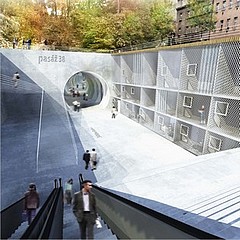
Another perspective on the functioning of the city is brought by the exhibition Anastomosis
 |
"All contemporary cities are similar - historical cores are museums for tourists, the periphery is expanding and consuming the surrounding landscape. The city is evolutionarily frozen. From the perspective of urbanism and infrastructure, it is firmly defined. Therefore, it painfully accepts new challenges and needs," said Petr Hájek, the head of the studio that led the two-year research of the students, to reporters today.
The exhibition presents 65 specific architectural proposals for four urban locations. In addition to connecting Prague's Karlín and Žižkov, the young architects also focused on linking Holešovice and Karlín via Štvanice Island and addressed the space beneath the park in Letná. In Karlovy Vary, the architects were tasked with finding new meaning for the concrete channels leading from the river from the spa colonnade to the pilgrimage site of Three Crosses; the channels are currently empty and filled with debris.
Each location is presented in 16 three-dimensional designs, accompanied by visualizations and technical drawings in a special installation with projections. The term "anastomosis" was borrowed by the architects from medicine and biology, where it denotes the connection of organ systems in the body.
"It is not futurism. It is about initiating a discussion. Anastomosis is not just a connection in the realm of architecture, but also in the realm of those who need to discuss the issue - on one side experts, on the other politicians who make decisions," Hájek added.
For example, the students creatively addressed the connection of Čech Bridge with Letná Park, which are separated by a triple barrier - the river, the road, and the slope. The task was to design an object that would connect everything while giving the place new significance. Students Šárka Doležalová and Eva Kubjátová proposed a gallery for the Slav Epic here, while Tereza Keilová, Dmytro Nikitin, and Dominik Saitl would like to see a memorial to the victims of communism.
On Štvanice and the adjacent banks, there could be a running circuit, an inflatable bridge, a water chapel, an aerial ferry, or a fishing village.
In Karlovy Vary, students proposed alternatives to the unattractive concrete channels, such as a film archive, a climbing wall, or a linear gallery.
All exhibited projects, developed in the studio of Hájek and Jaroslav Hulín, are feasible. The students consulted their work with structural engineers and other experts.
The unconventional exhibition will run at the DOX Centre until March 26.
The English translation is powered by AI tool. Switch to Czech to view the original text source.
0 comments
add comment
Related articles
0
26.11.2012 | The rector of ČVUT's award will be received in the research project category for the first time by the research on urbanism and architecture - ANASTOMOSIS by doc. Petr Hájek
0
24.02.2012 | Methods of teaching at universities of architecture and artistic focus
0
27.01.2012 | [anastomosis] - connected city
0
30.12.2011 | DOX will present the exhibition Anastomosis










